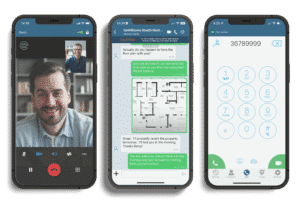
Make online communication about something more than just work. Allow time for people to get to know each other in ways that would happen organically if we were all together in a physical space.
One of our teams does a weekly “Humans on Our Team” Zoom meeting. They spend 15 minutes together on a Miro Board, where they add a picture of something that would help people understand who they are. Some weeks it’s all puppies and babies, other weeks it’s pictures of them with someone they lost, or someone who is sick or suffering. By sharing these moments with one another, they build camaraderie and even friendships. Attendance and participation isn’t required, but it’s a well attended and much anticipated time together every week.
Thank you so much for joining us in this interview series! Before we dive in, our readers would love to “get to know you” a bit better. Can you tell us a bit about your ‘backstory’ and how you got started?
I didn’t come from the world of software development or project management, so I had never even heard of Scrum or an agile way of working. At the urging of a friend one day, I visited a company that was using Scrum to see how it worked. Once I saw the happiness of the people working there, I was hooked and wanted to be a part of that magic. I still feel that way.
I’ve worked for Scrum Alliance before, back when we created the first agile coaching certification. I knew how valuable coaching was but had never done it in any official capacity, so I left for a position where I got to work as a junior agile coach in Eastern Europe. After that, I helped build an agile consulting firm called Big Visible, stayed with them through two acquisitions — SolutionsIQ & Accenture — then came back full circle to Scrum Alliance.
Can you please give us your favorite “Life Lesson Quote”? Can you share how that was relevant to you in your life?
My favorite life lesson is from my father. When I was a teenager and still figuring out what I “wanted to be when I grow up,” he told me: “It doesn’t matter what you want to be, as long as what you are is a man of integrity, a man of honor.”
I’ve never forgotten that. It’s who I am — it’s in my DNA.
None of us are able to achieve success without some help along the way. Is there a particular person who you are grateful towards who helped get you to where you are? Can you share a story about that?
While there are many people who have made a profound impact on my life, there are a few I would like to call out. One would be Jim Cundiff, particularly in recent years. His encouragement and advice as I’ve taken on my new role at Scrum Alliance have been invaluable, and I appreciate his counsel and mentorship to this day. Another person I’ve learned a lot from is John Rudd. Watching his personal journey with agile and seeing him go from being primarily numbers driven to someone who was driven by human needs taught me so much.
To begin, can you articulate for our readers a few of the main benefits of having a team physically together?
When teams are physically together, they have far higher bandwidth in terms of both communication and collaboration. Team members can actually see how people are feeling, without them having to describe it. It’s so much easier to get an understanding of emotion and tone when people are face to face.
Additionally, the “water cooler’’ or “hallway” conversations that spontaneously happen as people physically move about the space add texture to the dynamics of culture and collaboration. I’m not sure it’s possible to replicate that remotely, though we certainly do try.
On the flip side, can you articulate for our readers a few of the main challenges that arise when a team is not in the same space?
Building off my previous response, it’s no secret that it’s much harder to collaborate via Zoom or other online services. There will always be the value of in-person, human interaction. While the current remote working conditions enable us to connect with colleagues, friends, and family from all across the globe, they still inhibit our ability to foster human connection the same way we used to prior to the pandemic.
I see a few of the main challenges all relate to the lack of in-person connection. Whether it’s employees feeling burnout or losing motivation, the company feeling like its culture isn’t the same or just productivity feeling lower than normal, there are many issues that business leaders must meet head on in our “new normal.”
Fantastic. Here is the main question of our interview. Based on your experience, what can one do to address or redress each of those challenges? What are your “5 Things You Need To Know To Communicate With Your Team Effectively Even If You Are Rarely In The Same Physical Space ? (Please share a story or example for each.)
1 . Make online communication about something more than just work. Allow time for people to get to know each other in ways that would happen organically if we were all together in a physical space.
One of our teams does a weekly “Humans on Our Team” Zoom meeting. They spend 15 minutes together on a Miro Board, where they add a picture of something that would help people understand who they are. Some weeks it’s all puppies and babies, other weeks it’s pictures of them with someone they lost, or someone who is sick or suffering. By sharing these moments with one another, they build camaraderie and even friendships. Attendance and participation isn’t required, but it’s a well attended and much anticipated time together every week.
2. Leverage and utilize cameras in most distance-based communication. Turning cameras on for meetings is a far better experience than audio only. You can tell a lot about emotion and how people are feeling just by the look on their face. Plus, sometimes you get insight into shared interests and experiences.
Just the other day, I was in a conversation with a teammate and happened to notice something different in their background. I asked about it and it turned out that she had bought a blanket rack to display some antique quilts that came from her great grandmother. I shared that we had a quilt rack for my wife’s family quilts as well. We found something in common just because our cameras were on. Simple things like that help people connect.
3. Respect a timebox. In remote work, the line between home and work is blurred. We are all on our computers much more than we wish to be, which can lead to online fatigue. To help fight this tendency, keep meetings fairly short and to the point. Build in opportunities to get up and move. And while I still think cameras are important, it is a good idea to schedule one of your meetings each day as a walking meeting, either outside, or just around the house or yard.
4. Schedule in a little chaos and fun. Invite teams to social events on a regular cadence. Our company had a once a month trivia night and has occasional happy hours. When someone leaves or joins the company, we still do all of the fun and meaningful traditions we used to do in person. Laughter is one of the best things you can do for your teams. Make time for fun.
5. The stories we tell are even more important when we’re remote. When you’re remote, it’s easy to feel isolated and alone in the work you are doing. Leaders need to actively seek out ways to help team members feel connected to the larger story of what we are all achieving together.
One way to do that is by sharing a virtual information radiator of the organization’s goals via Slack or a shared document. Another way we do this at Scrum Alliance is through a storytelling channel on Slack. People use that channel to post or share stories, such as a customer impact story they have experienced or a time when a teammate went above and beyond the call of duty.
Has your company experienced communication challenges with your workforce working from home during the pandemic? For example, does your company allow employees to use their own cell phones or do they use the company’s phone lines for work? Can you share any other issues that came up?
We haven’t experienced many communication challenges. We use our own cell phones, Slack calls, Zoom calls, and any other tools at our disposal to make sure we stay in contact with each other, both one on one and as teams. We’re also exploring some innovative virtual office environments to help us feel even more like we’re sharing the same space, virtually.
Let’s zoom in a bit. Many tools have been developed to help teams coordinate and communicate with each other. In your personal experiences which tools have been most effective in helping to replicate the benefits of being together in the same space?
As I mentioned above, I think being on camera and still being able to see your teammates react in real-time is extremely valuable, which is why I value Zoom. Until we’re able to physically be together for our most important meetings, being on camera through some sort of conferencing tool is the best alternative.
If you could design the perfect communication feature or system to help your business, what would it be?
I miss the feeling of being together in the same space with people. I feed off the excitement of seeing people work together in a room with a big whiteboard or of watching the flurry of activity that comes when people collaborate on a project. If I could find a tool that let me experience that energy of great minds at work, I’d jump on it.
I also want a tool that allows for more spontaneous camera-on conversations with people, without scheduling another meeting. I miss walking around the corner, seeing someone I haven’t spoken to in a while, and popping my head in just to say hi.
My particular expertise and interest is in Unified Communications. Has the pandemic changed the need or appeal for unified communications technology requirements? Can you explain?
The way I understand Unified Communications, the same message is made available via all the tools and channels. What I really find that I need is a way to spread one message but in different ways, depending on what’s most appropriate for a particular channel and audience — some sort of help taking a long speech I give, for example, and figuring out how to parse it into a Twitter thread, a story on our storytelling channel, a blog article for our customers and a message to our Board. That would help me.
I recognize that repeating communication is important and that people need to hear a message multiple times to absorb it, but what I need is a way for them to consume it that won’t feel like more noise for them.
The technology is rapidly evolving and new tools like VR, AR, and Mixed Reality are being developed to help bring remote teams together in a shared virtual space. Is there any technology coming down the pipeline that excites you?
I love shiny objects, but I’m not an early adopter. We’ve beta tested some VR in-office environments that I loved, but quite a few of our team members didn’t enjoy it at all. Some of them even experienced motion sickness. Even so, as the world gets smaller and as more people can work together around the globe in real-time, I’m very interested in what the future of coworking will be.
Is there a part of this future vision that concerns you? Can you explain?
While technology is making distance-based communication easier and more robust, I do ponder the implications of how so much remote interaction affects us as human beings. We have a supremely human need for face-to-face time with other humans. I don’t think I want to live in a world where we only interact online.
For example, I’ve watched my boys interact with people over a video game. I can only hear one side of the conversation, but my boys are rolling in laughter and clearly enjoying the company of their online gaming companions. But when I invite those same friends over in person, I’ve noticed they are all a bit awkward together and can’t think of things to say. Remote interactions are a great occasional substitute for being in-person, but they are not a replacement for that feeling of being with other people in real life.
So far we have discussed communication within a team. How has the pandemic changed the way you interact and engage your customers? How much of your interactions have moved to digital such as chatbots, messaging apps, phone, or video calls?
One of the really interesting things we noticed at the start of pandemic lockdowns was that we were seeing an influx of participants in our seminars who previously couldn’t attend due to travel restrictions. I had a lot of folks who were new to our seminars telling me how much they loved our online workshops, and how prior to the pandemic they had no realistic way of making it to our in-person events.
It really has been great to see how many people have been able to attend our events when they previously wouldn’t have been able to. For the time being, the vast majority of our interactions and communications at Scrum Alliance have been digital through Zoom, Slack, etc. and we don’t see that changing anytime soon. Once things do return to “normal,” we will likely keep a majority of our online events available, in hopes of accommodating the folks who cannot make the in-person sessions.
In my experience, one of the trickiest parts of working with a remote team is giving honest feedback, in a way that doesn’t come across as too harsh. If someone is in front of you much of the nuance can be picked up in facial expressions and body language. But not when someone is remote. Can you give a few suggestions about how to best give constructive criticism to a remote team member?
I learned an important lesson about feedback from NASA. When Houston needs to talk to their astronauts, they don’t just start by talking on the microphone. They start with, “Endeavor, this is Houston, are you there?” And after a pause, the astronauts will answer back, “Houston, this is Endeavor. We are ready to receive.”
Too often, when giving feedback, we forget to check in and ask permission as to whether the person on the receiving end is in the right frame of mind for that kind of conversation.
Another thing I’ve learned is that if feedback is given at regular, frequent intervals, it becomes less threatening and more a part of the cultural DNA. Scrum builds feedback loops into the end of every sprint so that teams can learn to expect it, but also so they can learn to look forward to it as a way to learn and grow.
Can you give any specific ideas about how to create a sense of camaraderie and team cohesion when you are not physically together?
I mentioned most of them earlier. We use tools that allow for real-time communication. We encourage our teams to interact via video and webchat, and we make sure to set aside time for us to get to know each other better outside work.
Be human. Laugh often. Find ways to create moments of joy every day.
How can our readers further follow your work online?
Readers can stay up to date with Scrum Alliance by reading our blog and following Scrum Alliance on Facebook, Twitter, and LinkedIn. They can also follow me personally on Twitter.
Thank you so much for the time you spent doing this interview. This was very inspirational, and we wish you continued success.
About The Interviewer: David Liu is the founder and CEO of Deltapath, an award-winning unified communications company that liberates organizations from the barriers of effective communication. Liu is known for his visionary leadership, organic growth strategies, and future-forward technology. Liu is highly committed to achieving a greater purpose with technology. Liu’s business insights are regularly featured in Forbes, Entrepreneur Magazine, Tech Crunch, and more.



